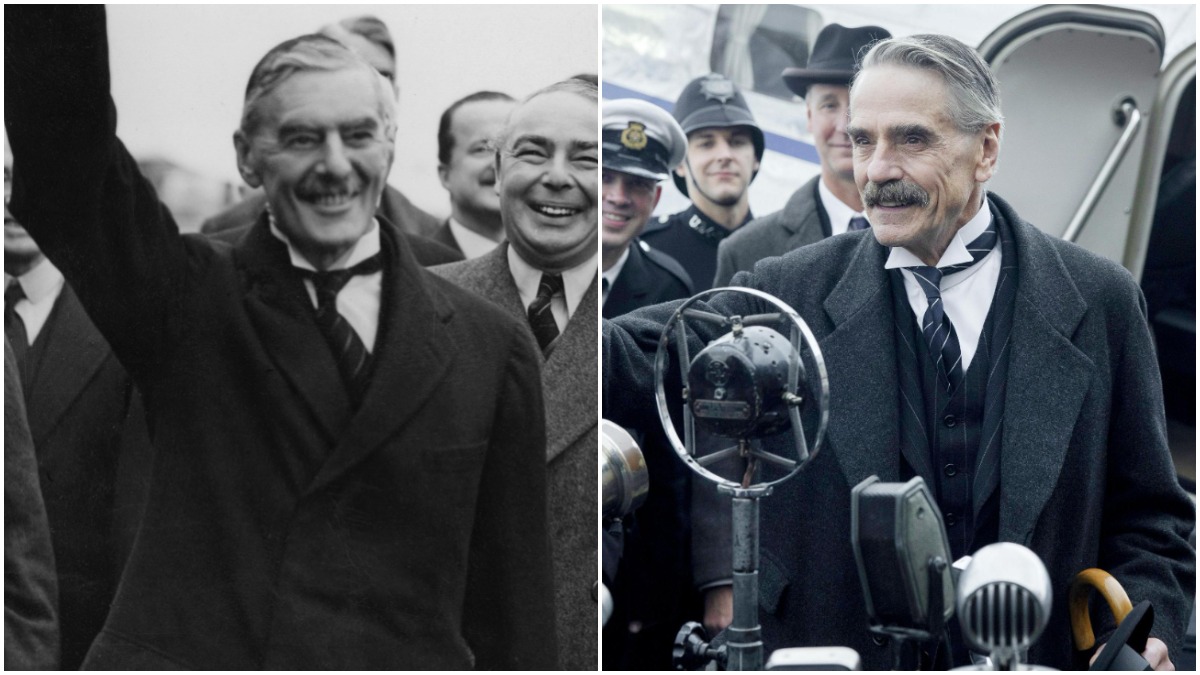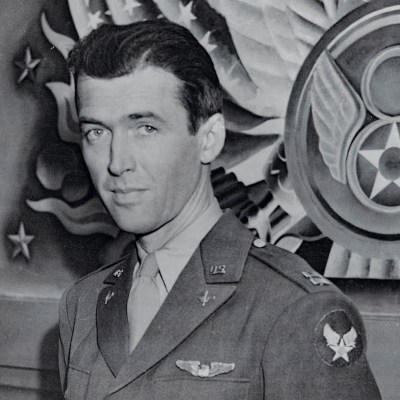One of the best aspects about Netflix and director Christian Schwochow’s Munich: The Edge of War is how acutely it makes you feel like it’s 1938. With its clandestine midnight meetings in hotel rooms and ministry offices, and its strained government officials struggling to grasp the full horror of what’s staring them in the face, the new film reminds audiences of the indecision and uncertainties which clouded the view for many on the path to World War II.
Yet with the film’s thriller plotting—complete with a last ditch effort by a German official to meet with British Prime Minister Neville Chamberlain on the eve of the Munich Agreement, begging him to reconsider his faith in Adolf Hitler’s word—a question might arise: what is fact and what is fiction? Below we’ve broken down some of the historic events which presaged the setting of Munich, as well as behind-the-scenes overtures that likely inspired the plot of the film and Robert Harris’ source material novel.
The Sudetenland Crisis
As quickly relayed in the backdrop of Munich: The Edge of War, the Sudetenland crisis arose from the aftermath of the First World War. Under the Treaty of Versailles in 1919, the nation of Czechoslovakia was created primarily from the Czech crown lands as they existed under the Austro-Hungarian Empire. This included Bohemia, Moravia, and Slovakia—as well as the border area that Germans referred to as “Sudetenland.” While this borderland had been part of a Czech state in one form or another since the ninth century, settlement of this land by German speakers dated back to the Middle Ages. Thus by the early 20th century, and after Germany became a unified nation in 1871, the land became increasingly under dispute.
In 1933, the same year Hitler rose to power in Germany, the Sudeten German Party (or “Front of the Sudeten German Homeland”) was formed under the leadership of Konrad Henlein. By April 1938, Henlein was threatening violence unless the territory was brought into “the frontiers of the Reich” (under Hitler’s urging, Sudeten Germans did eventually commit terrorist attacks against non-German neighbors, particularly Jews).
The immediate reaction of Chamberlain’s British government, as well as its French ally, was to advise Czechoslovakia to make Sudetenland an independent state. The Czech government eventually agreed, but by this point Hitler and the Third Reich’s propaganda was painting Czechoslovakia as a tyrannical state committed to continuing a history of atrocities against Sudeten Germans. Nazi Germany mobilized 750,000 troops along the German-Czech border in August.
In Netflix’s Munich movie, Jeremy Irons’ Chamberlain deciding to meet with Hitler seems like a radical (and arguably ill-advised) epiphany, but the Munich Conference was actually the British Prime Minister and German dictator’s third meeting within a month over the crisis. From their first sit-down, Chamberlain became resigned to surrendering the Sudetenland to Germany in hopes of staving off war. However, even Chamberlain grew disturbed when during their second meeting at Bad Godesberg on Sept. 22, Hitler demanded all of Czechoslovakia, as a “fraudulent state,” to be broken up. Hitler later walked back this demand but still expected cession of Sudetenland by Oct. 1 or there would be invasion. Meanwhile France was mobilizing its army while the British mobilized its navy.
On Sept. 26, Hitler made a speech in Berlin where he claimed the Sudetenland would be “the last territorial demand I have to make in Europe.” It set the stage for the larger geopolitical events we see in the film, which at Benito Mussolini’s arrangement saw Nazi Germany, Fascist Italy, Great Britain, and France agree to cede the Sudetenland to Germany (the Czechs were not invited to the conference, hence it being known in the east as the “Munich Betrayal”). It also precipitated Chamberlain’s folly to think the Munich Agreement guaranteed “peace for our time.” In fact, despite agreeing only to claim the Sudetenland region, Germany fully subsumed all of Czechoslovakia in March 1939.
What Hugh Legat and Paul von Hartman’s Plot Was Based On
Are Munich’s protagonists Hugh Legat (George MacKay) and Paul von Hartman (Jannis Niewöhner) real historical figures? That’s likely the question most viewers have. The answer is a resounding no. They were invented to create some thrilling intrigue during the Munich Conference by author Robert Harris. However, Paul von Hartman’s desperate scheme to convince the British government not to sign a peace treaty with Hitler due to a plot in the German military to overthrow the Nazi Party is based on actual history.
As documented in Nigel Jones’ Countdown to Valkyrie: The July Plot to Assassinate Hitler, as early as the summer of 1938, a resistance against the Nazis within the German military was itching to remove Hitler from power, and with Britain’s help during the Sudetenland Crisis. But rather than a failed midnight rendezvous with Chamberlain during the Munich Conference, this actually took the form of illegal overtures made by a German general in August 1938.
In the hopes of preventing an invasion of Czechoslovakia, which he was convinced would lead to a disastrous conflict equal to the Great War, German Gen. Ludwig Beck sent Pomeranian landowner Ewald von Kleist-Schmezin to London to spread the message that if his agent could “bring me certain proof that England will fight if Czechoslovakia is attacked, [I] will put an end to this regime.”
Kleist-Schmenzin traveled under a false name to London where he contacted several leaders in the conservative party, including Sir Robert Vansittart, the Foreign Office’s German expert, as well as Winston Churchill. Perhaps also signaling the disconnect Chamberlain’s government had with reality, Kleist-Schmenzin had to convince Vansittart that Hitler was not being controlled by war hawks within the Nazi Party. Rather Kleist-Schmenzin insisted, “the only extremist” hellbent on war was the Fuhrer himself.
By Aug. 28, Chamberlain received three separate reports about Kleist-Schmenzin’s overtures, including most vocally from Churchill, who was ever outspoken in his suspicion of Hitler and the dictator’s presumed expansionist designs for Europe. Chamberlain, who was no fan of Churchill at this time, dismissed these reports. The British Prime Minister believed he could establish a personal rapport in-person with Hitler that would prevent a war. Also, perhaps not unfairly, Chamberlain was skeptical about the prospects of a German military coup succeeding, comparing Kleist-Schmenzin’s plot to 18th century Jacobites who fruitlessly schemed to return the Stuart family to the English throne.
On the same day as Chamberlain’s dismissal, Beck resigned from the German military, and the internal resistance against Hitler faded back into limbo before its ultimately failed assassination attempt on the Fuhrer in 1944.
Lebensraum and Hitler’s Expansionist Vision
As previously mentioned, on Sept. 26, 1939, Hitler announced in Germany that acquisition of the Sudetenland would be “the last territorial demand I have to make in Europe.” This set the stage for Chamberlain to take the Nazis at their word—hearing what he wanted to hear—and making a deal that legally sanctioned in international eyes Germany’s expansion. As far as I’m aware, no actual document was shared with Chamberlain or any other western European nation that put in black and white print Hitler’s grand vision for a war of conquest across Europe, a la the MacGuffin in Munich: The Edge of War. However, one might argue Britain and France should not have needed it. Churchill certainly made the case that this was Hitler’s endgame.
The concept of “lebensraum” is mentioned in the secret document Paul hands Hugh in Munich, and this German concept of “living space” predates an even unified Germany. The term goes back to 1860, and by the early 20th century became a concept Imperial Germany used to rationalize the need for colonialism—especially after Germany was nearly starved by Allied blockades during the First World War. Hitler first publicly used the “lebensraum” term in his 1925 manifesto Mein Kampf. In the text, Hitler dedicated a whole chapter on “Eastern Orientation or Eastern Policy,” which outlined the need for Germany to expand its borders to the east well beyond the frontier lines that existed before WWI. Instead Hitler foresaw conquest of eastern lands as an opportunity to create more land for a supposed surplus of German citizens, and an opportunity to seize resources that would theoretically prevent a blockade from starving the German people as it had in the Great War.
Under Hitler’s dictatorship, Germany annexed Austria in the spring of 1938, well before expanding into Czechoslovakia. Yet France and Britain took the Third Reich at its word that this would be the end of its expansionism. In less than a year, that was proven false as the Nazis conquered the rest of a now broken Czechoslovakia and began preparing for an invasion of Poland.
In an August 1939 speech to his commanders, Hitler said, “Our enemies have leaders who are below the average. No personalities. No masters, no men of action… Our enemies are small fry. I saw them in Munich.” Germany invaded Poland on Sept. 1, 1939, and a month later (after Chamberlain’s government declared war on Germany), Hitler began saying the quiet parts of the Nazi Party’s “lebensraum” principle out loud. In a speech to the Reichstag on Oct. 6, 1939, Hitler said there would be “a new order of ethnographic relations, that is to say, resettlement of nationalities.” To his generals, he conveyed this in the same month to mean a “racial struggle” that would require they “purify the Reich territory from Jews and [the Polish] too.”
Was Neville Chamberlain Buying Britain More Time?
One of the more surprising aspects of Munich: The Edge of War is it suggests that Chamberlain was aware on a certain level how doomed his efforts were to broker a peace with Hitler, and if it failed he was convinced he had bought Great Britain enough time to better mobilize and prepare for war with Nazi Germany.
This is certainly counterintuitive to the general historical view of Chamberlain and his entire era of leaders in western Europe as appeasers who failed to defeat Nazi Germany when it was more vulnerable in 1938 if not earlier. This view became increasingly popular after Churchill’s own memoir in 1948, The Gathering Storm, painted Chamberlain as a noble but misguided leader who failed to see Hitler for the threat he was. It’s worth noting that there’s been a counter-narrative that Britain and France had no choice but to appease Hitler in the mid and late 1930s given the ghosts of World War I hanging over all citizens, including a haunted Chamberlain. Even John F. Kennedy wrote a thesis in 1940 Harvard titled “Why England Slept,” in which he argued appeasement, including in Munich, was necessary because Britain and France were not prepared for war.
This is not the popular assumption among most historians who view Chamberlain’s choices as feckless and poorly executed. As for what was in the heart of the man? That is harder to say. If he was buying time for the UK and an inevitable war with Germany, as late as 1940 he still seemed vaguely unsure about which course to take in fighting that war.
Read more
While Chamberlain and the UK declared war on Germany in September 1939, after the Prime Minister was forced to resign in May 1940, paving the way for Churchill to become PM, Chamberlain remained the leader of the conservative party and a key member of Churchill’s war cabinet. During those tenuous early days which coincided with the collapse of France and the desperate evacuation of British forces from Dunkirk, Chamberlain’s Foreign Secretary Edward Wood, Earl of Halifax, remained in the same position for Churchill.
Halifax became first quietly and eventually openly antagonistic to Churchill’s policies while attempting to convince the cabinet to pursue a negotiated peace with Germany via Italy. Men in the war cabinet repeatedly described Chamberlain as somewhere between Churchill and Halifax, whose sense of appeasement visibly extended to the point of surrendering the United Kingdom to Nazi Germany.
Chamberlain never outright backed Halifax, but while he saw the need to resist Hitler by 1940, he had reservations about pursuing the fight as France capitulated. This suggests he may not have been the war strategist Munich implies. However, he was not the wholly despairing appeaser that other popular dramatizations, including the Oscar winning The Darkest Hour, conversely present. As in reality, it was Chamberlain’s eventual firm support of Churchill on May 28 that shored up the war cabinet around the current Prime Minister, ending Halifax’s efforts to negotiate a peace with the fascists. In the end, Chamberlain came to support Churchill’s fight to the bitter end strategy before his death in October 1940. Make of that what you will.
Munich: The Edge of War is streaming on Netflix now.


